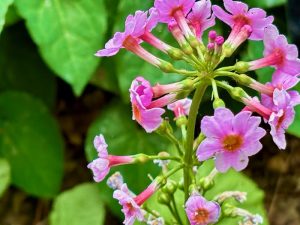Primula denticulata: The Drumstick Primula for Shady Spring Splendor
Primula denticulata, commonly known as Drumstick Primula, is a charming perennial that brings early-season vibrancy to the shaded garden. Native to the moist alpine regions of the Himalayas and parts of China, this hardy plant thrives in cool, damp conditions and provides bold floral displays when few others are in bloom. It’s a delightful choice for gardeners looking to inject spring color into woodland edges, boggy borders, and water-adjacent plantings.
Botanical and Ornamental Features of Primula denticulata
Drumstick Primula belongs to the family Primulaceae, which also includes other well-known early bloomers such as Primula vulgaris and Primula veris. This species stands out for its unique inflorescence structure: tight, spherical clusters of small flowers bloom atop upright stalks like colorful pompoms. Each rounded flowerhead measures around 8 cm (3 in) across and contains dozens of flat blossoms in shades ranging from lavender, pink, deep purple, and white, all marked by a bright yellow center.
The plant forms compact rosettes of coarse, wrinkled, oblong leaves that are finely toothed at the margins. In early to mid-spring, flowering scapes emerge from the center, rising 20 to 30 cm (8 to 12 in) tall. These dramatic blooms appear before many trees have leafed out, making Drumstick Primula an essential contributor to the spring display in shade gardens.
How to Grow Primula denticulata
Light
Primula denticulata performs best in partial shade, particularly in areas with hot summers. In cooler regions, it tolerates full sun if the soil remains consistently moist. Avoid exposure to intense midday sunlight, which may scorch its leaves.
Soil
Rich, humus-laden soil that stays consistently moist suits this plant best. It prefers neutral to slightly acidic pH and can tolerate clay or even boggy ground, provided the soil drains well enough to prevent standing water.
Watering
Moisture is key. Drumstick Primula requires steady watering, especially during dry spells. Do not allow the soil to dry out completely, but avoid soggy conditions that could lead to crown rot. Watering at the base helps reduce fungal risk.
Fertilizing
This primrose has modest feeding needs. Apply a balanced, slow-release fertilizer once in early spring as growth resumes. Overfeeding can result in lush foliage at the expense of flowers.
Mulching
A generous layer of mulch helps retain soil moisture, regulate temperature, and suppress weeds. Use organic materials like leaf mold, compost, or shredded bark. Mulch also protects roots during winter in colder zones.
Pruning
Deadhead faded flowerheads to encourage reblooming and prevent unwanted self-seeding. Cut back foliage after flowering if it becomes untidy, but leave it alone if the rosette remains vigorous.
Dividing
Every 2 to 3 years, divide clumps in early spring or fall. This rejuvenates older plants, increases airflow, and prevents overcrowding. Dividing also offers a perfect opportunity to propagate more plants for other parts of the garden.
Winter Care
Primula denticulata is cold-hardy down to USDA Zone 2. In very cold regions, apply mulch after the ground freezes to insulate the roots. In early spring, remove mulch gradually to allow new growth to emerge.
Where to Plant Drumstick Primula
Drumstick Primula adapts beautifully to various garden settings:
- Shaded beds and woodland edges
- Moist borders and bog gardens
- Along streams or near water features
- Rock gardens and alpine plantings
- Naturalized in meadows or under deciduous trees
For a spectacular show, plant in groups or drift plantings where their drumstick-like heads make a bold impact. Combine them with other shade-tolerant spring bloomers such as Pulmonaria, Brunnera, Dicentra, and spring bulbs.
Wildlife and Resistance
Despite its delicate look, Primula denticulata stands up well to common garden challenges. Deer and rabbits typically avoid it. The flowers attract early-season pollinators like bees and butterflies, making it a valuable plant for ecological gardens. Occasionally, aphids, vine weevils, slugs, or spider mites may appear, but infestations are usually minor. Keep an eye out during wet seasons.
Etymology and Background
The genus name Primula derives from Latin, meaning “first,” a nod to its early blooming nature. The species epithet denticulata means “small-toothed,” referencing the fine serrations along the leaf margins. The common name “Drumstick Primula” aptly describes the spherical flowerheads held aloft on bare stalks like ornamental drumsticks.
Awarded the prestigious Royal Horticultural Society’s Award of Garden Merit, Primula denticulata has proven itself a reliable performer in British gardens and beyond. Gardeners value it for its compact size, striking form, and ability to thrive in tricky, damp areas.
Final Thoughts
Primula denticulata is one of spring’s showiest perennials for shade. With its globe-shaped flowers in glowing jewel tones, tidy habit, and tolerance for wet soil, it’s an essential pick for anyone designing a shade garden with seasonal interest. Whether flanking a pond, nestled in woodland, or mixed with spring bulbs, this little primula always delivers big impact.
Include it in your shady planting scheme—you’ll be rewarded with cheerful blooms just when your garden begins to awaken.



